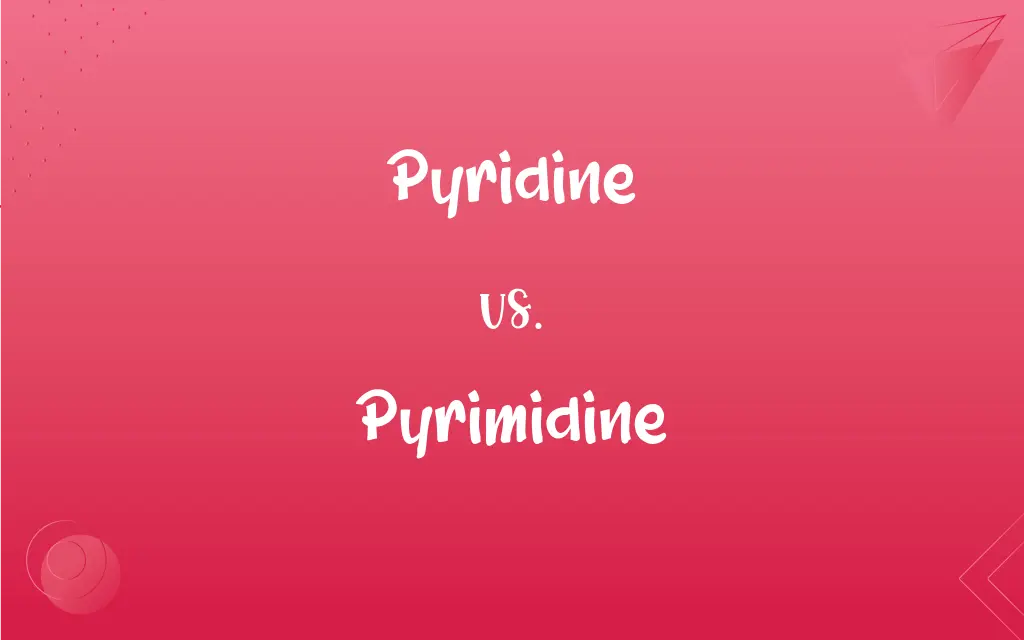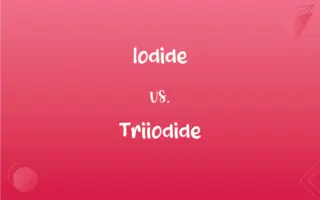Pyridine vs. Pyrimidine: What's the Difference?
Edited by Aimie Carlson || By Harlon Moss || Published on January 4, 2024
Pyridine is a basic, six-membered heterocyclic compound with one nitrogen atom, while pyrimidine is a six-membered ring with two nitrogen atoms.

Key Differences
Pyridine is an aromatic heterocycle with a single nitrogen atom replacing one of the carbons in a six-membered ring, known for its basic properties. In contrast, pyrimidine is also a six-membered heterocyclic compound, but it contains two nitrogen atoms at positions 1 and 3, and is a key component of nucleic acids.
In terms of chemical properties, pyridine is relatively basic due to the lone pair of electrons on the nitrogen atom, making it a useful solvent and reagent in organic chemistry. Pyrimidine, however, while also a heterocycle, plays a crucial biological role as part of the structure of nucleotides, the building blocks of DNA and RNA.
Pyridine finds widespread use in the synthesis of various pharmaceuticals, agrochemicals, and dyes due to its versatility and reactivity. On the other hand, pyrimidine bases, specifically cytosine, thymine, and uracil, are fundamental for storing and transmitting genetic information in organisms.
The lone pair on the nitrogen in pyridine contributes to its ability to act as a ligand in coordination chemistry, bonding with metals. In contrast, the structure of pyrimidine allows it to form hydrogen bonds, crucial for the double helix structure of DNA and the stability of RNA.
Pyridine is often synthesized from various raw materials in industrial processes, demonstrating its importance in synthetic chemistry. In biology, pyrimidine nucleotides are synthesized through a series of enzymatic reactions, reflecting its essential role in life processes.
ADVERTISEMENT
Comparison Chart
Chemical Structure
Six-membered ring with one nitrogen
Six-membered ring with two nitrogens
Key Properties
Basic, used in solvents and synthesis
Part of DNA/RNA, involved in genetic coding
Role in Biology
Not directly involved in genetic processes
Integral to genetic material
Industrial Use
Synthesis of pharmaceuticals, dyes
Less direct industrial use, more biological significance
Chemical Reactivity
Acts as a ligand in coordination chemistry
Forms hydrogen bonds in nucleic acids
ADVERTISEMENT
Pyridine and Pyrimidine Definitions
Pyridine
A compound with a distinctive, unpleasant odor.
The strong smell in the lab was due to pyridine.
Pyrimidine
Essential for genetic information storage and transfer.
Mutations in pyrimidine bases can lead to genetic disorders.
Pyridine
A ligand in coordination chemistry.
Pyridine forms complexes with transition metals.
Pyrimidine
A nitrogen-containing heterocyclic aromatic compound.
Pyrimidines are crucial components of nucleic acids.
Pyridine
A versatile chemical used in pharmaceutical synthesis.
Several antidepressants are synthesized using pyridine.
Pyrimidine
A base found in DNA and RNA.
Pyrimidine bases pair with purines in the genetic code.
Pyridine
A six-membered aromatic ring with one nitrogen atom.
The pyridine ring is a common motif in many drugs.
Pyrimidine
A six-membered ring structure with two nitrogen atoms.
Cytosine and thymine are pyrimidines in DNA.
Pyridine
A basic nitrogen-containing heterocyclic compound.
Pyridine is often used as a solvent in organic reactions.
Pyrimidine
Involved in hydrogen bonding in nucleic acids.
Pyrimidine bases form hydrogen bonds with their complementary purines.
Pyridine
A flammable, colorless or yellowish liquid base, C5H5N, having a penetrating odor and serving as the parent compound of many biologically important derivatives. It is used as a solvent and in the manufacture of various agricultural chemicals, rubber products, water repellents, dyes, and drugs.
Pyrimidine
A single-ringed, crystalline organic base, C4H4N2, that is the parent compound of a large group of biologically important compounds.
Pyridine
(organic compound) Any of a class of aromatic heterocyclic compounds containing a ring of five carbon atoms and an nitrogen atom; especially the simplest one, C5H5N.
Pyrimidine
Any of a group of substituted derivatives of pyrimidine, including the nitrogen bases uracil, cytosine, and thymine, which are components of nucleic acids. Barbiturates and certain other drugs are also pyrimidines.
Pyridine
A nitrogenous base, C5H5N, obtained from the distillation of bone oil or coal tar, and by the decomposition of certain alkaloids, as a colorless liquid with a peculiar pungent odor. It is the nucleus of a large number of organic substances, among which several vegetable alkaloids, as nicotine and certain of the ptomaïnes, may be mentioned. See Lutidine.
Pyrimidine
(organic compound) A diazine in which the two nitrogen atoms are in the meta- positions; it is the basis of three of the bases found in DNA and RNA: thymine, uracil and cytosine
Pyridine
A toxic colorless flammable liquid organic base with a disagreeable odor; usually derived from coal
Pyrimidine
Any of several basic compounds derived from pyrimidine
Pyrimidine
A heterocyclic organic compound with a penetrating odor
FAQs
What is pyridine?
A basic heterocyclic organic compound with one nitrogen atom.
What role does pyrimidine play in genetics?
It forms part of DNA and RNA, crucial for genetic coding.
What is pyrimidine?
A heterocyclic aromatic compound with two nitrogen atoms.
How is pyridine used in industry?
As a solvent and in synthesizing various chemicals.
Are pyridine and pyrimidine structurally similar?
Both are six-membered rings but differ in nitrogen atom count.
Which pyrimidines are in DNA?
Cytosine and thymine are the pyrimidines in DNA.
Is pyridine found in DNA?
No, pyridine is not a component of DNA.
Can pyridine form hydrogen bonds?
Generally, no, it acts as a base and ligand in reactions.
Are pyrimidines basic or acidic?
They are neither strongly basic nor strongly acidic.
What industries heavily use pyridine?
Pharmaceutical and agrochemical industries.
How are pyrimidine nucleotides synthesized?
Through a series of enzymatic reactions in cells.
Do pyrimidines pair with purines in DNA?
Yes, through hydrogen bonding.
Is pyridine a natural or synthetic compound?
It can be both, but it is often synthesized industrially.
Can pyrimidine bases mutate?
Yes, leading to genetic variations or disorders.
Is pyridine a stable compound?
Yes, it is stable under normal conditions.
What are the health effects of pyridine exposure?
Inhalation can cause respiratory and eye irritation.
How do pyrimidines contribute to genetic diversity?
Through variations and mutations in their structure.
What is the smell of pyridine?
It has a distinctively unpleasant, fish-like odor.
What is a common use of pyridine in laboratories?
As a solvent in chemical reactions and extractions.
Do pyrimidines participate in DNA replication?
Yes, as fundamental components of nucleotides.
About Author
Written by
Harlon MossHarlon is a seasoned quality moderator and accomplished content writer for Difference Wiki. An alumnus of the prestigious University of California, he earned his degree in Computer Science. Leveraging his academic background, Harlon brings a meticulous and informed perspective to his work, ensuring content accuracy and excellence.
Edited by
Aimie CarlsonAimie Carlson, holding a master's degree in English literature, is a fervent English language enthusiast. She lends her writing talents to Difference Wiki, a prominent website that specializes in comparisons, offering readers insightful analyses that both captivate and inform.

































































